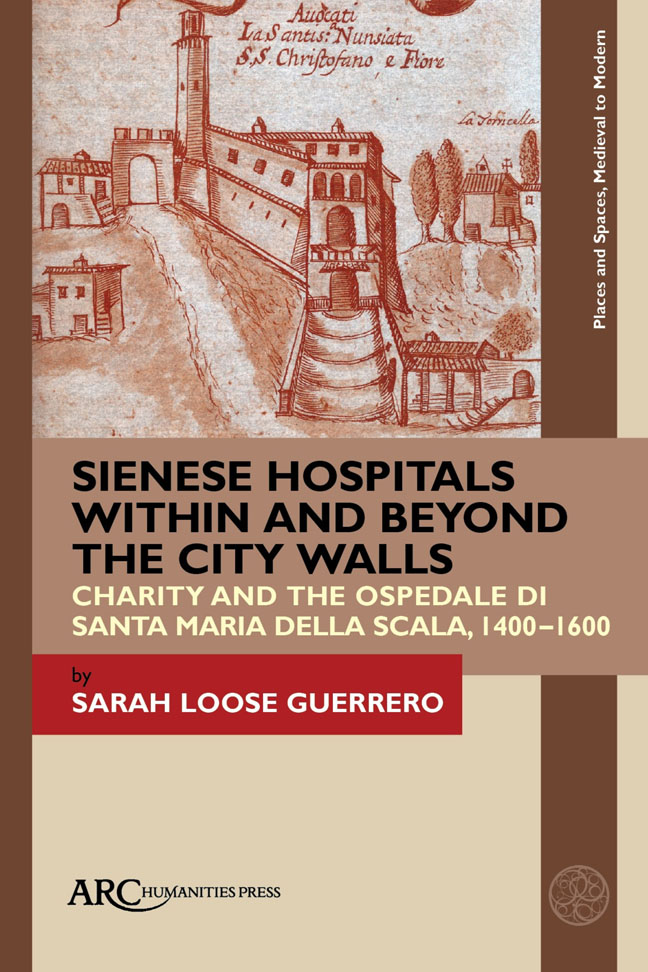 Sienese Hospitals within and beyond the City Walls
Sienese Hospitals within and beyond the City Walls Published online by Cambridge University Press: 17 February 2024
Sometime in the late eleventh century the canons of Siena's cathedral founded a xenodochium or pilgrim's hostel, across the piazza from the church. Dedicated to the Virgin Mary, this small establishment benefited from its connection to the cathedral and its prominent urban location. Donations and broad support from Siena's citizens transformed the original hostel into a multi-service hospital, the Ospedale di Santa Maria della Scala, by the thirteenth century, and one of the most powerful institutions in the city by the fourteenth. The hospital's power derived from its roles in caring for the poor and providing individuals with a means of expressing religious devotion through charitable giving, as well as its wealth and economic resources. By the fourteenth century, the bulk of Santa Maria della Scala's income derived from its vast land holdings. It is estimated that the hospital owned close to one-third of the countryside surrounding Siena, which extended the reach of this urban charitable institution into rural spaces. As a source of income in both cash and kind, Santa Maria della Scala's rural patrimony was key to the function and success of the hospital.
This narrative of a powerful urban charitable institution will sound familiar to those acquainted with the study of hospitals and poor relief in late medieval and early modern Europe. Within the historiography, hospitals have traditionally been studied in an urban context and scholars have investigated the role of charitable institutions in the civic, social, economic, and religious life of the city. However, by focusing on the city, the traditional narrative most often takes for granted and obscures the ways in which urban hospitals extended their influence beyond city walls. Like Santa Maria della Scala, most hospitals owned property of some kind, and many had rural possessions. Because charitable institutions generally used the lands they owned to generate income, it has long been a tendency to assign an economic role to patrimonies and to reference or consider them only in this way. Beyond economics, the relationship between the urban and rural spaces of charitable institutions remains largely unexplored.
This book examines the Ospedale di Santa Maria della Scala di Siena and its urban and rural spaces from 1400–1600 to show that there is much to be investigated, from the social and religious ties that existed alongside the economic, to the manner in which urban and rural spaces negotiated their relationships.
To save this book to your Kindle, first ensure no-reply@cambridge.org is added to your Approved Personal Document E-mail List under your Personal Document Settings on the Manage Your Content and Devices page of your Amazon account. Then enter the ‘name’ part of your Kindle email address below. Find out more about saving to your Kindle.
Note you can select to save to either the @free.kindle.com or @kindle.com variations. ‘@free.kindle.com’ emails are free but can only be saved to your device when it is connected to wi-fi. ‘@kindle.com’ emails can be delivered even when you are not connected to wi-fi, but note that service fees apply.
Find out more about the Kindle Personal Document Service.
To save content items to your account, please confirm that you agree to abide by our usage policies. If this is the first time you use this feature, you will be asked to authorise Cambridge Core to connect with your account. Find out more about saving content to Dropbox.
To save content items to your account, please confirm that you agree to abide by our usage policies. If this is the first time you use this feature, you will be asked to authorise Cambridge Core to connect with your account. Find out more about saving content to Google Drive.